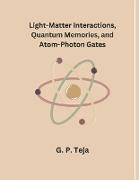- Start
- Light-Matter Interactions, Quantum Memories, and Atom-Photon Gates
Light-Matter Interactions, Quantum Memories, and Atom-Photon Gates
Angebote / Angebote:
The idea of a classical computer is well known to us. A computer in its rudimentary form is a device that takes information in terms of classical bits, performs logic gates on the bits and yields output-bits. Whereas a quantum computer (QC) uses two-level quantum systems (qubits) for computation. In QC's the qubits are typically initialized in a desired state or a superposition state. Then unitary rotations (gate-operations) are applied and ¿nally the output states are measured. A variety of systems are being explored to realize a practical quantum computer e.g. superconducting qubits (SQ) [1, 2], trapped ions [3], Rydberg atoms [4], quantum dots [5, 6] and photonic systems [7, 8]. The physical systems that act as qubits are realized using the various degrees of freedom of the system, e.g. energy levels of atoms and ions, charge states in quantum dots and the charge and ¿ux states of SQ. The initialization, gate operations and readout of the qubits are performed using light-matter interactions. For photonic qubits polarization can be used for encoding a qubit. Such encoding is ideal for communication, as the polarization qubits doesn't have a bath. But the two-qubit gate operations are di¿cult with polarization qubits, as photons do not interact easily. For quantum computation with photons, the qubits are encoded in an in¿nite-dimensional harmonic oscillator [9], and the gate operations are performed using beams splitters, phase shifters, homodyne detectors and number resolving detectors.
Folgt in ca. 10 Arbeitstagen
